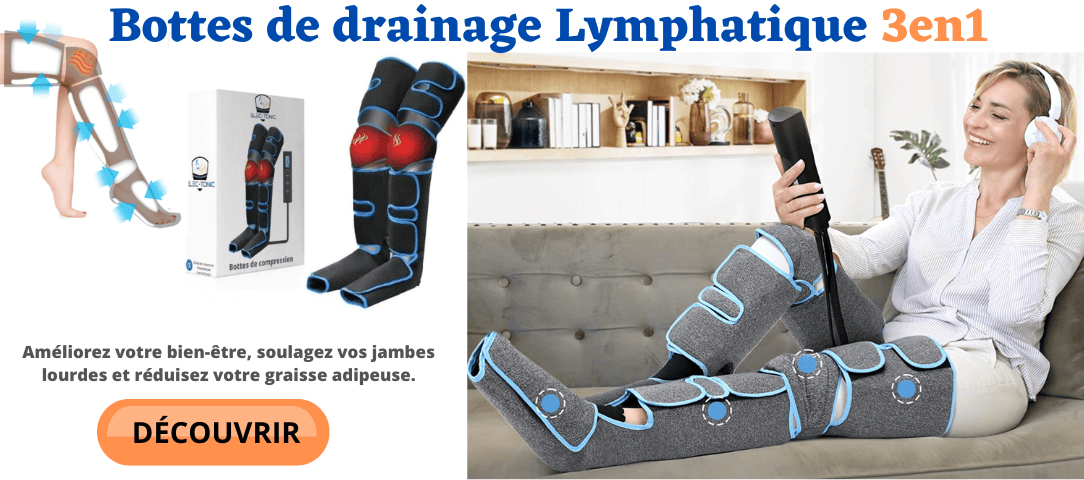Feet that seem to have doubled in size by the end of the day, ankles that look like rubber rings... Leg swelling, called edema, can be uncomfortable and painful. In this context, lymphatic drainage is often presented as an effective solution. But is this really the case?
Summary :
- Introduction : Lymphatic drainage and swollen legs.
- Lymphatic drainage: Its role and impact.
- Identify the problem: Signs of circulatory problems.
- Anecdote: Sophie's story and her fight against edema.
- Natural remedies: Complementary solutions
- Pressotherapy: An alternative to lymphatic drainage.
- Conclusion : Take the necessary measures for your swollen legs.
Understanding Lymphatic Drainage and Its Impact on Swollen Legs
Lymphatic drainage is a technique of massage A specialized treatment traditionally reserved for healthcare professionals. Its goal is to stimulate lymph flow and help reduce swelling. Historically, this treatment was primarily performed in medical offices or specialized health spas, making access and consistency difficult for some.
However, thanks to the evolution of technology, home solutions are now available, allowing individuals to benefit from these treatments comfortably at home, at their own pace. It is in this context that our product, pressotherapy boots, finds its relevance. They offer a practical and effective alternative to traditional lymphatic drainage.

Although most people report improvement after lymphatic drainage, results can vary. Some people may not experience significant relief, especially if they have severe circulation problems. In these cases, adding a regular home treatment, such as pressotherapy, can significantly improve symptoms.
Varicose Veins and Venous Insufficiency: The Hidden Culprits
Varicose veins, a visible form of venous insufficiency, can also cause swollen legs. They are the result of distorted blood vessels that disrupt blood flow, particularly in the lower extremities. Lymphatic drainage can help alleviate symptoms, but it will not eliminate the underlying cause.
Heavy legs and swollen ankles: When should you worry?
Swelling in the legs and ankles can be a common symptom, especially after a day of standing or sitting at a desk. However, if the swelling persists or is accompanied by other symptoms, such as a feeling of heaviness or fatigue in the legs, it could indicate a more serious circulation issue, such as poor venous return. If you find yourself searching for "heavy legs at night what to do?" frequently, it may be time to consult a healthcare professional.
Let's take Sophie's example. She suffered from heavy legs and swollen ankles every night. Her symptoms worsened even after trying several home remedies. Eventually, she discovered she was suffering from poor venous return.Through a combination of lymphatic drainage and pressotherapy, she managed to find significant relief.
Pressotherapy: An effective alternative to lymphatic drainage for swollen legs?
Pressotherapy, a method that uses air pressure to stimulate lymphatic and blood flow, is another option you may want to consider. Studies have shown that pressotherapy can be particularly effective to relieve the symptoms of heavy legs, especially in combination with other treatments.
Additionally, with pressotherapy devices now available for home use, this method may be a more convenient and accessible option than lymphatic drainage.
Natural remedies: Complementary solutions
There are also natural remedies that can help relieve the symptoms of venous insufficiency and improve leg comfort. For example, red vine is known for its venotonic properties, which help tone veins and improve blood circulation.
Additionally, regular massages can help stimulate blood circulation. Applying cold water to the legs can also provide temporary relief from swelling and cramps.
In conclusion, lymphatic drainage may be an option for treating swollen legs, but it's not necessarily the only solution. If you're experiencing poor leg circulation or heavy legs and swollen ankles, it's important to consult a healthcare professional to discuss the best treatment options for you.
And don't forget: there are alternatives like pressotherapy that can be just as effective. Don't let swollen legs ruin your life. Take action today!